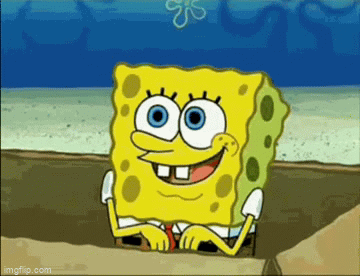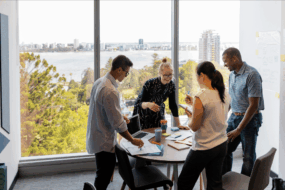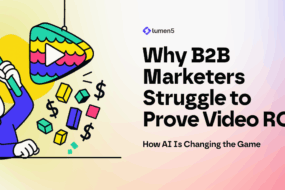
It’s long been known that video is the most engaging type of content, holding the audience’s attention while also being easy to digest. And while its functionally impossible to create viral content (major brands have been trying and failing for years), a video has a better chance of going viral more than anything else.
I mean, how many times has a video accidentally gone viral? Or has someone’s reaction become a meme? (We love you, Kim K!) Why does it go viral? What’s the secret sauce? It’s not that no one knows, there’s actually a bit of science behind it.

See, video content greatly uses a set of strategies collectively known as ✨ emotional marketing ✨ The million dollar question is: How can your brand create powerful campaigns that drive meaningful results through all stages of the customer journey?
It all starts with using video and the power of emotional marketing.
PART 1: EMOTIONAL MARKETING
What is Emotional Marketing, Exactly?
How exactly do we define emotional marketing?

Let’s try breaking it down. Emotional = strong feelings, how we strongly feel. Marketing = something brands do to interact with their audience. So.. could it be defined by how brands want customers to feel when interacting with the brand?
Well.. yes and no. There’s a bit more to it than just branding 101.
Emotional marketing, is basically a catch-all term for any marketing or advertising strategy that relies primarily on emotional appeals to convert. People notice, discuss, and purchase from you not strictly because of what you offer, but because of how you make them feel.
While emotion tends to be quite nuanced and complex, most can be broken down into one of eight primary umbrellas:

Rational marketing is the closest thing to emotional marketing’s ‘opposite’ that exists. It focuses far more on proving a product or brand’s merits to the audience – much more of a “here’s my product, it’s great.. now buy it” approach. Hence why rational marketing is roughly half as effective as emotional marketing. Who cares if your new phone provides a faster processing speed and better screen resolution? What does this mean to me?
What makes emotional marketing SO powerful.
First, it’s memorable. Stop and think about your most memorable experiences, and what’s the first thing that comes to mind? ‘Betcha it was something related to how you felt, wasn’t it?
It creates instant reactions. Anyone who says they’re purely logical is lying. Yes, we’re calling out you super logical thinkers — you still use emotions to make decisions. After all, humans are emotional creatures by nature, and those emotions often make us react before we’ve even realized it.
It inspires action, as well. Emotional marketing is very good at creating a sense of urgency. People are more willing to commit to a purchase either out of excitement, nostalgia, or from FOMO — which 69% of people experience.
Finally, it’s empathetic. People want to feel appreciated and understood. And only a few strategies are better at conveying that feeling more than emotional marketing. Why do you think “Emotional Damage” got so popular?

Building A Basic Framework for Emotional Marketing
Plenty of established brands leverage emotional marketing to stand out in a saturated market. Just look at Wendy’s Twitter — the sass is UNREAL. And on National Roast Day, every brand better beware and watch out because NO ONE is safe! They’ve truly marketed themselves in a unique way by clearly showcasing their brand voice and tone.
But it’s also the key for companies that are just getting started. By coming in strong, understanding your customers, and making them the heroes right out the gate, you’re setting yourself up for success.
How do they want to feel after finding a solution, and how do you want them to feel? How will buying from you help them become a better version of themselves, and what’s the best way to convey that?
Think about how every element of your visuals and messaging comes across, and how it can be tweaked to create the emotional experience you desire.
Colour plays a major role in guiding purchase decisions. And yet content, forms, shapes, sounds and composition also influence a purchaser’s choices. I mean, who can resist a giant red “SALE” button?
Understanding Emotional Targeting
Every decision we make in life is based on emotion. We all make emotional decisions and then try to justify them.
Talia Wolf, CEO and Founder of GetUplift
Emotional targeting seeks to influence those emotional decisions, and psychological triggers are probably one of the most critical concepts through which that is achieved. These are the common motivators, cognitive biases, and behavioural patterns that push people to act. They are themselves tied to a higher concept known as the adaptive unconscious.
TLDR, the adaptive unconscious refers to the underlying mental processes through which our brains take and analyze the immense stream of data they constantly receive. To say that these processes have a significant impact on our judgment and decisions would be putting it lightly.
Did you know that we make roughly 95% of every decision subconsciously? So your late night snack run to McDonald’s or ShareTea wasn’t because you were “hungry”, it was probably because you were craving it or wanted it.. Am I right or am I right? And that’s where we get into the core goal of emotional marketing.
Unfortunately, flying cars and teleportation don’t exist yet, so mind reading technology is probably still a few decades off. So for now, I guess we’ll have to settle and rely on these key tactics to learn about our customers:

The goal here is twofold. First, to gain a better understanding of your audience. Second, to build a deeper connection with them — per Harvard, emotionally invested customers are 52% more valuable to brands than those who are just highly satisfied.
PART 2: EMOTIONAL MARKETING & VIDEO
Applying Emotions Throughout the Funnel
Have you ever considered what customers want from your brand?
Your goal is to transform the customer journey into the experience they’re looking for. When you understand the people behind the screen, you understand how to sell to them. And one of the first insights anyone involved in emotional marketing comes to understand is that people don’t purchase based solely on features, benefits, or pricing.
We buy better versions of ourselves. That’s why a brand that demonstrates knowledge of its audience is so successful. They understand how to show each customer how they can be better with the brand’s solutions, and how they can aspire to even higher goals.
Like Nike and their ad campaign: Never Settle, Never Done. Brands that understand can create relatable content that leverage the right emotions, milestones, and messaging. And the numbers don’t lie. 70% of people who experience an emotional response are very likely to purchase the product.
That’s why applying emotional marketing in tandem with neuroscience allows marketers to make prospects feel like they’re making the right choice, even in B2B settings. Combined with our own experience, neuroscience also allows us to predict the emotions created by our content — though in the long-term, the best way to know for certain is via A/B testing.
Where Video Fits In
With video, everything about emotional marketing comes together in one place. You’re able to trigger emotions through visuals, audio, and words, communicating with your customers on a variety of levels while greatly deepening loyalty in the process. Simply put, emotional storytelling is a huge part of successful video content.
A good video catches the eye and captures the mind in seconds. Don’t believe us? What comes to mind when you see Old Spice? There’s a good chance it’s the hilariously over the top commercials featuring Terry Crews or Isaiah Mustafa. And guess what? That brand recognition likely made you buy Old Spice when shopping.
Same thing goes for McDonalds in the late 1990s and early 2000s. Who can forget that classic Ba Da Ba Ba Bah, I’m lovin’ it slogan? Don’t worry, we won’t judge if you Uber Eats a Big Mac after reading this.
The reality is simple: emotional video works because it taps into our insecurities and desires in the immediate.
So here’s the TLDR:
- Make your customers the hero of your videos
- Give your brand a face that the audience can relate to
- Present common issues, questions, or concerns the audience may experience, and explain how to overcome them
- During video production, consider what stage of the funnel you’re at, and what emotions you want to inspire
- Diversity is key – videos should not only feature ideals customers, but also people in your organization, real-life testimonials, product demos, and explainer videos.
Understanding the Power of Emotional Marketing
We have gut reactions in three seconds or less. Emotions process sensory input in only one-fifth of the time our conscious, cognitive brain takes to assimilate that same input. Quick emotional processing also happens .. Our emotional reaction to stimulus resounds more loudly in our brain than does our rational response, triggering the action to follow.
Dan Hill, Author of Emotionomics: Leveraging Emotions for Business
Emotional marketing is incredibly powerful, that much is clear by now. Psychological triggers exist everywhere, and can be applied everywhere. The most important thing is to make sure your content is consistent and targets the right audience in a way that’s meaningful to them.
Beyond that, it really just boils down to knowing your customers — even better than they know themselves.

Are you looking to go all-in with emotional marketing? You don’t need to be the next Spike Lee to strike an emotional chord. You only need to understand who your customers are, where they are right now, and where they want to go.
So get out there young Picasso and start creating! 🎨🧑🏼🎨





